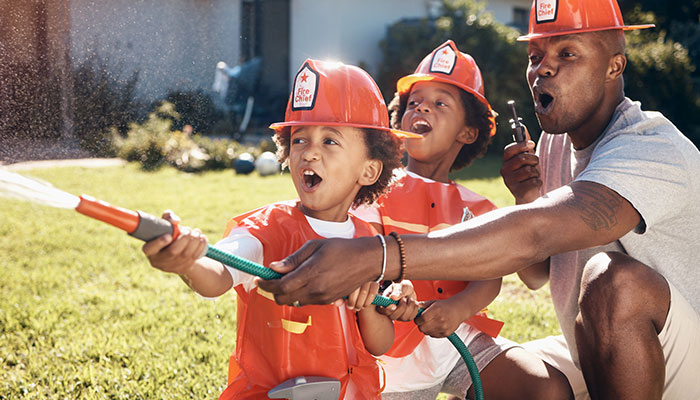While we believe that the books and resources recommended may be of value to you, keep in mind that these are suggestions only and you must do your own due diligence to determine whether the materials are appropriate and suitable for your use. PNC has no sponsorship or endorsement agreement with the authors or publishers of the materials listed.
COMMUNITY HELPERS

Under Pressure
Children will learn about firefighters and their responsibilities as community helpers.

Lesson Objective
Children will explore water flow and pressure and learn how firefighters need and use water in their job.
Science
What You'll Need
- ½ gallon empty milk or juice container – 1 per child
- Phillips head screwdriver or sharp scissors to make holes in the container
- Water
- Large, shallow container to catch the water such as a tub or a basin
- Variety of waterproof containers from the recycling bin – one for each child
- Masking tape
- Paper towels or beach towels
What To Do
Note: This lesson involves the use of water. You may want to do the activity outside.
- Read a story about firefighters. Talk about what they do and the objects and materials that help them do their job. If the children mention water, respond with some probing questions. Otherwise, ask how firefighters stop fires from spreading - what do they use? Where does the water come from? How do they get the water to the fire? They need a lot of water, and they need the water to be fast and powerful. How do they do that?
- Let the children watch as you poke three holes through one side of the ½ gallon container. The holes should all be the same size and in a row. The first hole should be about 3 inches from the bottom of the container. The second hole should be directly above the first hole and midway up the side of the container. The third hole should be directly above the other two holes and near the top of the container.
- Cover all of the holes with one large piece of the masking tape.
- Fill the container with water. Set the container on the edge of a table above the shallow container or on the ledge of the sink or on a chair or stool above the water table. The higher the container is from where the water will land, the more interesting it will be.
- Ask the children, “What do you think will happen if I take the tape off of the holes?” Remove the tape. Watch the children and listen to their observations as the water flows from the holes.
- What happened when I took the tape off? Did water come out of all of the holes?
- Was it the same for each hole? Did some water come out faster or slower? Did the water come out of the holes the same way? Did some water flow out and land closer or further from the container and into the sink, water table, basin?
- Gather the children and let each child choose one of the empty plastic containers that you collected. Tell the children that they will be doing a similar experiment. They can choose to poke 1, 2, or 3 holes anywhere on their container. Go around the group and use the screwdriver to create the holes that they ask for.
- As each child is ready, let them begin to experiment with the water. If you are inside, station small groups of children at the water table, the sink, and around the basin.
- Ask questions such as: What do you think will happen when you put water in your container?
- Encourage the children to compare the streams that flow from the different holes. Does the water flow out of each hole in the same way? Is some water coming out faster/slower? Does some of the water go further?
- Can the children experiment further by covering some of the holes or changing the amount of water that they pour into their container?
- Give the children an opportunity to share and compare their discoveries with each other.
Resources
Home School Resources
Home educators: use these printable lesson PDFs to teach this lesson to your home schoolers. They're available in English and Spanish.
Content Provided By
Common Core State Standards Initiative – These lessons are aligned with the Common Core State Standards ("CCSS"). The CCSS provide a consistent, clear understanding of the concepts and skills children are expected to learn and guide teachers to provide their students with opportunities to gain these important skills and foundational knowledge [1]. Visit the CCSS


